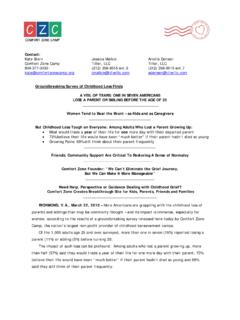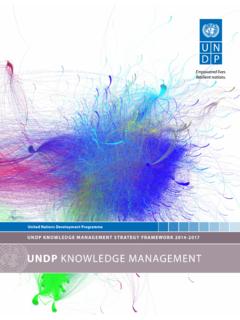Transcription of BENCHMARKING MIAMI’S GROWTH AND COMPETITIVENESS
1 BENCHMARKING miami S GROWTH AND COMPETITIVENESSR ichard FloridaSteven PedigoTHE miami URBAN FUTURE INITIATIVE The miami Urban Future Initiative is a joint initiative with FIU s College of Communication, Architecture + The Arts and the Creative Class Group sponsored in part by The John S. and James L. Knight Foundation, which will lead new research and mapping on economic, occupational, creative and technological assets in miami , in partnership with renowned experts, to provide necessary data, evidence and strategy to grow a more inclusive, creative economy for a 21st century global miami .
2 miami has reached a crossroads. Its economy historically based on tourism, hospitality, transportation, and real-estate development has deepened, diversified, and become more creative and idea-based, as banking, media, arts, education, and new technology-based industries have assumed a larger role. The region now finds itself at a critical inflection this Initiative, we hope to provide the thought leadership and awareness required to guide miami s evolution as a global city through data-driven research and assessments of the key trends shaping the region.
3 Disseminate this information and inform the broad strategic vision for the region s private and public stakeholders through ongoing local convenings and briefs and bring global thought-leaders and practitioners to bear on thinking about the region s future through high-level events and convenings on issues important to miami and global cities.@MIAU rbanFuture miami S GROWTH AND COMPETITIVENESSR ichard Florida is a university professor and director of cities at the Martin Prosperity Institute at the University of Toronto, a distinguished fellow at New York University s Schack Institute of Real Estate, and a visiting fellow at Florida International University.
4 He serves as senior editor for The Atlantic, where he cofounded and serves as editor at large for CityLab. He is also the author of the award-winning The Rise of the Creative Class. His latest book, The New Urban Crisis, was published by Basic Books in April 2017. Steven Pedigo is the Director of Research for the Creative Class Group, a global think tank comprised of leading researchers, academics and strategists. He is also the Director of the NYU Schack Institute of Real Estate Urban Lab and a Clinical Assistant Professor for Economic Development at the NYU School of Professional Studies.
5 Steven holds a bachelor s degree from the University of Texas at Austin and graduate degrees from the H. John Heinz III School for Public Policy and Management at Carnegie Mellon University and the University of Illinois at Urbana-Champaign. THE AUTHORSRICHARD FLORIDA STEVEN PEDIGO@Richard_Florida @iamstevenpedigohe miami metro spanning miami -Dade, Broward, and Palm Beach counties has grown at a stunning rate over the last five years. Today, miami s population gains outpace those of Los Angeles, San Francisco, Boston, and Washington, But does this influx of residents translate into sustained and shared economic GROWTH ?
6 Not all GROWTH is created equal. A metro s population may rise as its employment and income levels decline, and vice versa. In order to build a stronger, more inclusive economy, metros must increase their economic output, employment, wages, incomes, and key businesses and industries alongside their following research brief from the miami Urban Future Initiative provides a data-driven assessment of the economic GROWTH and COMPETITIVENESS of the miami metro, comparing its performance in recent years to all 53 of America s large metros with populations of more than one million miami S GROWTH AND COMPETITIVENESSTM etricValueRank among Large MetrosPopulation Size (2016) million8 Population GROWTH (2011-2016) 19 GROWTH in Economic Output (2011-2016) 13 Wage GROWTH (2010-2015) 18 Income GROWTH (2010-2015) 42 Employment GROWTH (2010-2015) in Business Establishments (2010-2015) 8 Average Size of Business Establishments (2015) in Business Establishment Size (2010-2015)
7 25 Traded Sector Establishments (2015)54,8424 Traded Sector Business Establishment (LQ)* (2015) 1: miami s Overall COMPETITIVENESS Rankings*Note: Location quotient, or LQ, refers to how concentrated an industry is compared to the as a whole. GROWTH is on an annualized basis. Definitions and sources for all metrics are listed in the - @creative_classKEY FINDINGS miami s population is large, but its population GROWTH is relatively slow. With more than six million residents, miami ranks eighth among large metros according to its population size, which is comparable to that of Philadelphia and Washington, But, miami ranks 19th in terms of population GROWTH , with a GROWTH rate of percent per year.
8 This is better than the national average but worse than fast-growing metros like Austin, Houston, Nashville, and Denver. miami s employment has grown rapidly. miami had the sixth highest rate of employment GROWTH ( percent annually) among large metros between 2010 and 2015. This exceeds the national average but lags leading knowledge hubs like San Francisco, Austin, and San Jose. miami has experienced sharp business GROWTH . miami has the eighth highest rate of business GROWTH among large metros (roughly 2 percent annually). This is considerably better than the national average and rates for New York, Los Angeles, and Washington, but worse than the rates for Austin, Dallas, and Houston.
9 miami has a substantial concentration of key export-oriented or traded sector businesses. miami takes fourth place behind the much larger metros of New York, Los Angeles, and Chicago on its level of traded sector businesses. miami s economy is highly dependent on small businesses. On average, miami s business establishments are smaller than those in any other large metro. This is not surprising for an economy driven by hospitality, tourism, and real estate industries. Nevertheless, it signals miami s lack of larger companies, which provide higher-paying jobs and make for a more resilient economy.
10 miami s economic output is large, but the GROWTH of its economic output lags leading tech hubs. miami s economic output, or GDP, is roughly $288 billion, placing it 12th in the , just behind Seattle. From 2011 to 2016, the metro s GDP grew at a rate of 3 percent per year, exceeding the national average of percent. Still, miami s GDP grew at less than half the rate of San Jose s or Austin s. miami has seen reasonable wage GROWTH , but suffers from a slower rate of income GROWTH . miami ranks 18th in terms of its wage GROWTH , which increased at an annual rate of percent between 2011 and 2016.







